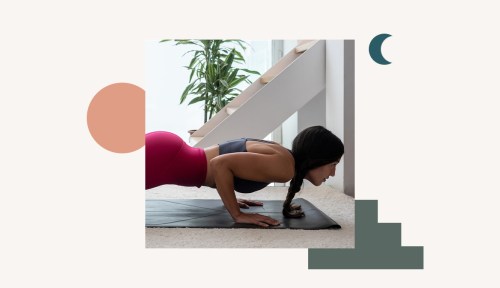It may have taken years of sitting slumped over a desk to screw up your posture, but according to trainers, you only need a small window of time to make things right. Carving out time on your calendar for 10-minute posture workouts can work wonders for helping you hold those shoulders back after a long day of work.
Experts in This Article
a personal trainer and founder of More than Miles
physiotherapist, master Pilates instructor, and founder of Go Chlo Pilates
Chris Stockel is a fitness trainer and the owner of MindBodyProject, a HIIT and meditation studio in New York City.
Danielle Cote is a barre instructor and the director of training Operations for Pure Barre.
certified personal trainer and director of training and experience at StretchLab
ACE certified trainer, functional training specialist and running coach with the EvolveYou app
Before we get into the workouts, though, let’s dial it back to basics: In the simplest of terms, posture refers to how your body holds itself. As Melissa Kendter, a personal trainer with the fitness-focused app Tone and Sculpt puts it, “having a strong, well-balanced body promotes movement, efficiency, and endurance, and contributes to our overall well-being.” In other words, aside from simply helping you stand (or sit) taller, good posture can also help you carry out everyday movements with ease.
While you may notice the effects of poor posture in your upper body, improving it requires work all over. According to Kendter, you’ll want to strengthen your posterior chain (aka the muscles in the back of your body), your neck, core, and glutes for the sake of the cause. The reason? “Stronger muscles in your back will keep you in an upright position and help you hold your shoulder blades back and down,” she says. “By maintaining strength in your abdominal region and leg muscles, it will better align your spine and pelvis.”
The good news, though, is that there are plenty of ways for you to work all of these critical areas—and doing so requires you to just do 10-minute posture workouts for each. Keep scrolling for trainer-approved workouts from every modality that will help perk up your posture, stat.
The best 10-minute posture workout for 5 different fitness modalities
1. Strength
This bodyweight workout focuses on building strength through push-and-pull motions, which are critical to improving your posture. “Push-pull patterns fall into the foundation of functional fitness, which is at the core of asymmetrical balance and posture throughout your body,” says Anthony Crouchelli, director of talent and master trainer at membership-based workout platform Liteboxer. In this EMOM-style series (which stands for “every minute, on the minute”), you’ll cycle through three moves every minute for 10 minutes straight. Do eight repetitions of each, then use the remaining time to rest before you start it all over again.
- 1.T raises: Standing upright, hold your arms out to the side of your body so that they make a letter T with your torso. Hold them at shoulder height, squeezing your shoulders back behind you. Return to start and repeat eight times.
- 2.Y raises: Raise your arms into a Y shape above your head (think: the first part of the YMCA dance) with your palms facing forward, squeezing through your shoulders. Return to start and repeat eight times.
- 3.Negative push-ups: Start in a plank position, and use the muscles in your core, chest, and back to lower all the way to the ground for five seconds (the slower, the better). Next, use your knees to quickly push your body back up to plank. Repeat eight times.
2. HIIT
Looking for a workout that will fix your posture and get your heart rate up? Chris Stockel, the owner of NYC’s MindBodyProject Studio, has a solution: “When working your posture, your posterior chain should be the main area of focus,” he says, pointing to your glutes, hamstrings, and thoracic spine as the primary areas you’ll want to be targeting. These muscles are responsible for all the work that comes from the backside of your body (as in, walking, sitting, squatting), but can start to suffer when you spend hours every day slumped over a desk, which, in turn, impacts your posture.
“When the body is stuck in a seated position, the anterior, or front, chain of the body becomes extremely tight while the posterior, or rear, chain becomes increasingly tense and dysfunctional,” Jeff Brannigan, a co-founder of Stretch*d, previously told Well+Good. “As the head falls forward, the spine curves outward, which results in the muscles throughout the rear neck and upper back compensating and attempting to hold the head upright.” With that in mind, this series of moves will stretch and strengthen all the right spots in your posterior chain. Improved posture is only seven minutes away.
- 1.Cat-cow stretch: Start kneeling on all fours in a tabletop position with your wrists under your shoulders and your knees under your hips. Inhale and gaze forward, engaging your core, then exhale and tuck your chin to your chest as you drop your head and draw your belly button toward your spine, rounding your vertebrae toward the ceiling. Exhale and return to tabletop, then inhale and look forward as you push your stomach toward the mat. Lift your tailbone toward the ceiling, drawing your chest and sternum forward and up. Return to tabletop and repeat for one minute.
- 2.Plank walkouts: From a standing position, place your hands on the floor and walk them out into a plank position. Hold for a beat, then walk your hands back to your feet and stand up. Repeat for one minute.
- 3.World’s greatest stretch: Lower down into a lunge position with your right leg forward and your left leg extended straight back behind you. Place your left hand on the floor, next to your right foot, and twist your body to extend your left arm up toward the sky. Hold for 30 seconds, then repeat on the other side.
- 4.Glute bridges: Lying on your back with your feet planted firmly on the floor, press through your heels to lift your butt off of the ground. Squeeze your glutes when you reach the top, hold for a beat, then return to start. Repeat for one minute.
- 5.Jump squats: From standing, bend your knees to lower down into a squat position. Remember to push your weight into your heels, keep your knees over your toes, and hold your chest proud. Jump up and slice your hands down and behind you, then land softly with your knees bent. To modify the move, take out the jump and do air squats instead. Repeat for one minute.
- 6.Hand-release push-ups: Start in a plank position with your hands on the floor underneath your shoulders and your feet together. Lower down into a push-up, keeping your body straight the entire time. When you reach the bottom of the move, lift your hands an inch off of the floor, holding your head still. Return your hands to start, and repeat for a minute. If this feels too advanced, try it from your knees, or simply cycle through some regular push-ups instead. Repeat for one minute.
- 7.Mountain climbers: Think of this move as a “running plank.” From your standard high-plank position, pull one knee at a time toward your chest as quickly as you can, taking care to engage through your core and hold your body in a straight line. Repeat for one minute.
3. Stretching
If a full workout isn’t on the menu, Kelsey Decker, NSCA-CPT and education coordinator for StretchLab, suggests spending 10 minutes cycling through the following stretches. These moves work your spine, chest, hips, shoulders and core, which she says “tend to be the most compromised areas when we sit for too long, repeat incorrect movement patterns, experience high stress, work out consistently, or experience low flexibility.”
- 1.Cat-cow stretch: In a tabletop position, start with a flat back and shoulders over your wrist, knees in contact with the ground and in line with your hips. Begin the movement by tucking your chin to your chest, pushing up through your shoulders to round out your upper back, and tuck your hips under your body by pulling your core in to allow for a stretch through your spine. Reverse this movement to lengthen through your chest and core, untuck your hips, let your stomach drop allowing an arch in your lower back, round back your shoulders, and bring your head to your upper back. Repeat this several times using your breath to move you through the movement.
- 2.Upward dog to downward dog: Starting in a high-plank position, push your weight up toward the sky and back so that your glutes are in the air and your weight is primarily back toward your feet. (You should look like a mountain top). You can be on your toes or try to bring your heels toward the ground to stretch your calves. Arms should be straight to help distribute the weight between your hands and feet. To transition to upward dog, shift your weight to your hands and drop your hips toward the floor. Roll your shoulder back to open your chest. Hold these positions for 20 to 30 seconds, working on diaphragmatic breathing to relax and stretch the front and back muscles of the body.
- 3.World’s greatest stretch: Start in a runner’s lunge: left leg in front in, place both hands on the inside of the front foot with your back knee off the ground. Rotate toward your front left knee with your left hand coming off the ground and reach toward the sky. Follow this hand with your eyes to rotate through your spine. This stretch works by mobilizing the ankles, hips, and thoracic spine. Repeat on each side three times and hold each stretch for 20 seconds, or move in and out of the stretch to add dynamic movement.
4. Barre
“One of the best ways to improve your posture is to focus on exercises that target your core,” says Danielle Cote, director of training operations for Pure Barre. “Engaging these muscles helps with flexibility, stability, and overall strength.” In this ballet-inspired workout (which, for what it’s worth, doesn’t require an actual barre), you’ll work through a series of movements that target all 360 degrees of your core, then treat your muscles to a few full-body stretches. The result? After 10 minutes, you’ll be feeling strong and loose all over, two components that will surely benefit your posture.
- 1.Teasers: Lie flat on your back with your arms extended overhead, your legs zipped together, and your toes pointed. Roll up for four counts, then roll back down for four counts. Repeat three times. Then, roll up for four counts, hold the move at the top and extend your arms forward with your legs either straight or bent to a tabletop position. Hold for 10 seconds.
- 2.Forearm plank: Come to your forearms with your feet hip-width apart. Pull your abs in to engage your core (think about holding your body in a straight line from the top of your head down to your toes). Float your right foot off the floor with your toes pointed; hold for 30 seconds, then repeat on the other side. Place both feet on the floor, press your heels back, and hold for 30 seconds. Push up into a straight arm plank, draw your right knee into your chest and hold for 20 seconds, and repeat on the other side. Place both feet on the floor and hold your high plank for 20 seconds.
- 3.Push-ups: Come up to either a full-plank position (to modify, put your knees on your ground), with your hand slightly wider than your shoulders. Lower your chest to the floor, press up to straight arms, and repeat 10 times. Then, lower down to the bottom of the move and hold for 10 seconds at the lowest point.
- 4.Bridges: Lie on your back with your arms by your side and your feet hip-width-distance apart. Press your hips up into bridge position, squeezing your glutes at the top. Extend your right leg straight up, lower it down so that it’s parallel to your left knee, and repeat 15 times. Extend your leg back toward the sky, and lower and raise your hips in small pulses 20 times. Repeat this series on the other side. Then, plant both feet on the floor, and lower and raise your hips all the way to the floor 10 times. Hold your hips at the top of the move and pulse up and down 20 times.
- 5.Back extension: Lying flat on your stomach with your legs slightly wider than your hips, reach your arms out in front of you with your palms facing each other. Engage your upper glutes and back to lift your arms and legs off of the floor, and hold for 20 seconds. Lower back down to the floor, and repeat three times.
- 6.Cat-cow: Come to your hands and knees. Drop your head, round through your spine and bring your gaze toward your navel, and hold for a cat stretch. Arch your back, push your hips, chest, and chin up, and hold for a cow stretch. Repeat three times.
- 7.Forward fold stretch: From a standing position, bring your feet about hip-width distance apart. Carefully fold forward and take a light grip behind your calves or ankles to draw your chest toward your thighs. Bend your knees slightly, soften your hips joints, and allow your spine to lengthen. Draw your chin toward your chest and allow your head to feel heavy.
5. Pilates
Pilates, as a practice, is all about working your body’s stabilizing muscles, which are important for holding your body upright. In this workout, led by Chloe de Winter, founder of Go Chlo Pilates, you’ll focus on the serratus anterior, which wraps underneath your shoulder blades and helps support your shoulders and upper back. Through a series of twists, you’ll work your balance, which will help build the core strength you need to maintain proper posture. Though some of the exercises might feel easy, they pack a bigger punch than you may realize. “We’re working directly into those postural muscles that help us sit or stand with better posture throughout the day. The big muscles have to work hard—we have to build and strengthen them,” says de Winter. Follow along with the video above to try it for yourself.
Oh hi! You look like someone who loves free workouts, discounts for cutting-edge wellness brands, and exclusive Well+Good content. Sign up for Well+, our online community of wellness insiders, and unlock your rewards instantly.
Sign Up for Our Daily Newsletter
Get all the latest in wellness, trends, food, fitness, beauty, and more delivered right to your inbox.
Got it, you've been added to our email list.










